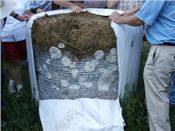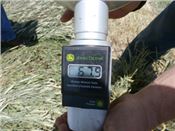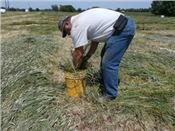Making Quality Hay Or Haylage

Very moldy hay due to holes in the covering.
Photos courtesy: MU Extension
MT. VERNON, MO.
A lot goes into making high-quality hay. Perhaps the primary way to produce the kind of hay that will give top milk and meat production is to cut the hay at the optimum stage of maturity.
Whether it’s a cool-season grass, a warm-season grass, wheat hay or a legume crop they all have an ideal time to be cut for peak quality according to Eldon Cole, livestock specialist with University of Missouri Extension.
For optimum quality, orchardgrass and fescue should be cut in the boot to early head stage. Alfalfa quality usually peaks in the bud to one-tenth bloom stage. Red clover is best cut in the early bloom stage. Small grains are best cut in the boot to the early head stage, like fescue.
Peak quality is usually defined as a forage with low neutral detergent (NDF) and low acid detergent fiber (ADF). That typically translates into a hay or haylage with 60 percent or greater total digestible nutrient (TDN) and crude protein (CP) value of 12 to 20 percent or greater. These values are on a dry matter basis.
PROPER MOISTURE
After cutting the hay, the next critical practice in making hay suitable for a blue-ribbon at a hay show or for hungry animals is to bale it at the proper moisture. Small rectangular bales should be baled ideally at no more than 20 percent moisture. Large hay packages are best baled in the 16 to 18 percent range for dry hay.
“Haylage or baleage is growing in popularity in this area and a desired target on moisture is 40 to 60 percent with 50 percent being about ideal. These targets, for both dry and high moisture forage, are sometimes hard to hit,” said Cole.
Determining moisture is not an exact science but farmers develop various methods of “getting in the ballpark.” Most rely on the feel of the hay as they hold and twist it or kick it.
Some new methods are now available to determine moisture more accurately. A basic microwave oven and a small scale that weighs in grams can do the job nicely with high accuracy.
Details on the process are available in the “Agriculture Guide Sheet 3151 – Using A Microwave Oven to Determine Moisture In forages” online at http://extension.missouri.edu/p/G3151
Dry hay baled with moisture levels above 22 percent lose dry matter due to excessive heating, molding and even in some cases spontaneous combustion is possible. In the latter case, hay barns may even be burned to the ground.
A few farmers have invested in hay moisture testers. Prices range from $100 up to $600 or even more. Most feel the testing is reliable and has reduced their moldiness in dry hay.
“Moldy hay usually does not cause problems in cattle other than refusal to eat it. Horses are more sensitive to moldy hay, and only non-moldy hay should be fed to them,” said Cole.
Moisture testers appear to be most helpful in determining when to wrap high moisture hay.
“Wrap as soon as possible after baling, hopefully within four hours. Be sure to keep the wrapped bale hole free. Even fairly small holes can result in significant moldiness. Other mold problems may arise from inadequate wrapping and delaying wrapping for two or so days,” said Cole.
Be careful how you move the bales. If holes develop, promptly cover the holes with the special tape. The adage, “easy does it”, is especially true when handling plastic-wrapped haylage.
“Stored forage is expensive so if you can save losses due to waste from harvest to feeding you’ll be money ahead,” said Cole. ∆

The results, 67.9 percent shows up on the probe.

Packing hay into a 5 gallon bucket for testing with the probe.